Royal Pelinese Navy (Pacifica): Difference between revisions
RobbyTheSeal (talk | contribs) mNo edit summary Tag: 2017 source edit |
RobbyTheSeal (talk | contribs) mNo edit summary Tag: 2017 source edit |
||
| (56 intermediate revisions by the same user not shown) | |||
| Line 1: | Line 1: | ||
{{infobox military unit | {{infobox military unit | ||
|unit_name = Royal Pelinese Navy | |unit_name = Royal Pelinese Navy | ||
|native_name = | |native_name = ペリナイ海軍 | ||
|image = Pelinese Naval Jack.png | |image = Pelinese Naval Jack.png | ||
|image_size = 220px | |||
|caption = Naval jack of the Royal Pelinese Navy | |caption = Naval jack of the Royal Pelinese Navy | ||
|dates = {{start and end dates|1984|1|2|present}} | |dates = {{start and end dates|1984|1|2|present}} | ||
|country = [[Pelinai (Pacifica)|Kingdom of Pelinai]] | |country = [[Pelinai (Pacifica)|Kingdom of Pelinai]] | ||
|branch = [[Wikipedia:Navy|Navy]] | |branch = [[Wikipedia:Navy|Navy]] | ||
|size = 300,000 active personnel (2023)<br>approx. | |size = 300,000 active duty personnel (2023)<br>approx. 842 active ships (2025)<br>approx. 900 fixed-wing aircraft (2025) | ||
|command_structure = [[Pelinese Armed Forces (Pacifica)|Pelinese Armed Forces]] | |||
|garrison = Naval Staff Headquarters, Dainēsa | |garrison = Naval Staff Headquarters, Dainēsa | ||
|garrison_label = Headquarters | |garrison_label = Headquarters | ||
|nickname = ''White Fleet'' | |||
|patron = [[Saint Pelinai (Pacifica)|Saint Pelinai]] | |patron = [[Saint Pelinai (Pacifica)|Saint Pelinai]] | ||
|motto = | |motto = | ||
|colors = | |colors = White, blue<br>{{color box|white}} {{color box|#105ABC}} | ||
|colors_label = | |colors_label = | ||
|march = | |march = | ||
| Line 18: | Line 21: | ||
*12 [[Wikipedia:Aircraft carrier|aircraft carriers]] | *12 [[Wikipedia:Aircraft carrier|aircraft carriers]] | ||
*2 [[Wikipedia:Amphibious command ship|amphibious command ships]] | *2 [[Wikipedia:Amphibious command ship|amphibious command ships]] | ||
* | *5 [[Wikipedia:Landing helicopter dock|landing helicopter docks]] | ||
* | *11 [[Wikipedia:Amphibious transport dock|amphibious transport docks]] | ||
* | *11 [[Wikipedia:Dock landing ship|dock landing ships]] | ||
* | *26 [[Wikipedia:Landing ship, tank|landing ship tanks]] | ||
*24 [[Wikipedia:Landing ship medium#Light Amphibious Warship (LAW)|landing ship mediums]] | *24 [[Wikipedia:Landing ship medium#Light Amphibious Warship (LAW)|landing ship mediums]] | ||
* | *21 [[Wikipedia:Cruiser|cruisers]] | ||
* | *58 [[Wikipedia:Destroyer|destroyers]] | ||
* | *59 [[Wikipedia:Frigate#Modern frigate|frigates]] | ||
* | *61 [[Wikipedia:Corvette|corvettes]] | ||
* | *53 [[Wikipedia:Missile boat|missile cutters]] | ||
* | *116 [[Wikipedia:Mine countermeasures vessel|mine countermeasures vessels]] | ||
*96 [[Wikipedia:Submarine#Military|submarines]] | *96 [[Wikipedia:Submarine#Military|submarines]] | ||
* | *274 [[Wikipedia:Auxiliary ship|auxiliaries]]}} | ||
|equipment_label = [[List of active RPN ships (Pacifica)|Fleet]] | |equipment_label = [[List of active RPN ships (Pacifica)|Fleet]] | ||
|battles = {{plainlist| | |battles = {{plainlist| | ||
*[[ | *None ([[Pelinese Civil War (Pacifica)|Pelinese Civil War]] as PWA Naval Forces) | ||
}} | }} | ||
|battles_label = Engagements | |battles_label = Engagements | ||
|website = rpn.pln | |website = rpn.mil.pln | ||
|commander1 = [[Izumi II Perinaiko (Pacifica)|Izumi Perinaiko]] | |||
|commander1_label = CINC | |||
|commander2 = {{Pelinese official|current|minister of defense}} | |||
|commander2_label = Minister of Defense | |||
|commander3 = {{Pelinese official|current|chief of general staff}} | |||
|commander3_label = Chief of General Staff | |||
|commander4 = Fleet Admiral Georgiy Kaigin | |||
|commander4_label = Commander of Naval Operations | |||
|identification_symbol = | |||
|identification_symbol_label = Flag | |||
|identification_symbol_2 = [[File:Pelinese Naval Jack.png|160px]] | |||
|identification_symbol_2_label = Jack | |||
|identification_symbol_3 = | |||
|identification_symbol_3_label = Badge | |||
|identification_symbol_4 = [[File:RPN sleeve patch.png|160px]] | |||
|identification_symbol_4_label = Sleeve patch | |||
|aircraft_attack = | |||
|aircraft_bomber = Na-11 | |||
|aircraft_electronic = Ae-16R | |||
|aircraft_fighter = [[Aetherdyne Ae-16 Fuyuhana (Pacifica)|Ae-16]] | |||
|aircraft_helicopter = [[Berkut Be-19 Cornflower (Pacifica)|Be-19]], Yo-12 | |||
|aircraft_interceptor = | |||
|aircraft_patrol = [[Kaiyoko-Ruzikov KaR-15 Umidori (Pacifica)|KaR-15]] | |||
|aircraft_recon = [[Sesako Se-14 Kaiyōtori (Pacifica)|Se-14]] | |||
|aircraft_trainer = | |||
|aircraft_transport = | |||
|aircraft_tanker = | |||
|aircraft_general = | |||
}} | }} | ||
The '''Royal Pelinese Navy''' is the [[Wikipedia:Navy|maritime service arm]] of the [[Pelinese Armed Forces (Pacifica)|Pelinese Armed Forces]]. | The '''Royal Pelinese Navy''', also referred to as the Pelinese Navy, the White Fleet, or the White Navy, is the [[Wikipedia:Navy|maritime service arm]] of the [[Pelinese Armed Forces (Pacifica)|Pelinese Armed Forces]] and is responsible for maintaining its [[Wikipedia:Naval warfare|naval warfare]], [[Wikipedia:Coastal defense and fortification|coastal defense]], and [[Wikipedia:Amphibious warfare|amphibious warfare]] capabilities. It is the second largest branch of the Pelinese Armed Forces, with approximately 300,000 active duty personnel in 2023. | ||
The naval arm of the Pelinese Armed Forces has existed as an independent entity since January 2, 1984, when the primarily riverine naval forces of the [[Pelinese Civil War (Pacifica)|Civil War]]-era [[Pelinese White Army (Pacifica)|Pelinese White Army]] were divided into a separate branch of the armed forces. Ship and infrastructure construction programs proceeding since the 1990s, in addition to the procurement of vessels such as [[Wikipedia:Underway replenishment|underway replenishment]] ships, have since advanced the RPN from being primarily a [[Wikipedia:Littoral zone|littoral]] navy to a capable [[Wikipedia:Blue-water navy|blue-water]] force with extensive combat capabilities. | |||
The Royal Pelinese Navy is one of the largest navies in Pacifica, with a fleet size of over 840 ships and an estimated combined fleet tonnage of over 4,400,000 tonnes as of 2025, and forms a sizable portion of Pelinai’s overseas [[Wikipedia:Power projection|power projection]] capabilities. It contains seven branches of service: the RPN Surface Forces, the RPN Submarine Forces, the Royal Pelinese Navy Air Service, the RPN Coastal Defense Forces, the Royal Pelinese Marine Corps, the RPN Sealift Forces, and the RPN Special Forces. In addition to naval warfare assets such as naval vessels and navalized aircraft, different branches of the Royal Pelinese Navy also operate coastal defense missile batteries, land-based [[Wikipedia:Maritime patrol aircraft|maritime patrol aircraft]], amphibious ground forces such as marines, and other non-naval military assets. | |||
Pelinese naval officials have identified the [[Mediterranean Sea (Pacifica)|Mediterranean Sea]] and the [[Eastern Ocean (Pacifica)|Eastern Ocean]] as core theaters of operations for the Royal Pelinese Navy since 1985, and the RPN performs regular patrols across the eastern Mediterranean in particular. Regular naval patrols and exercises have both increased in frequency and crept westward as the Royal Pelinese Navy and the Pelinese Armed Forces in general have continued to make progress in force modernization and expansion. | |||
==Mission== | |||
The stated mission of the Royal Pelinese Navy is to create, maintain, and deploy military naval power capabilities in the defense the national and political independence of the Kingdom of Pelinai and its allies, the protection of the national interests of Pelinai, and the insurance of the safety of citizens of Pelinai and its allies. | |||
==History== | |||
===Origins=== | |||
===Pelinese White Army Naval Forces=== | |||
===Establishment as independent branch=== | |||
===Rearmament=== | |||
The end of the Cold War and the gradually increasing military-technical capabilities of the broader Pelinese Armed Forces brought significant changes to Pelinese naval doctrine and force structure during the period from 1984 to 2010. High-ranking naval officers such as Admiral Paraha Aliya had begun advocating for a Pelinese blue-water fleet as a hedge against the risks of relying on foreign allies for naval defense as early as 1985, leading to the initiation of the development program for new vessels such as the ''Takayama''-class guided missile destroyer and the Type 012 corvette; a variety of hurdles such as budget constraints, limits on the capabilities of available industrial facilities to construct advanced warships, and significant difficulties in the design and construction of the ''Takayama'' class, however, acted to restrain the pace and scope of naval modernization programs for the rest of the 1980s. | |||
<!--Surface combatant development in the 1990s--> | |||
<!--Increased focus on navy--> | |||
<!--Nuclear & aircraft carrier programs--> | |||
<!--New external focus--> | |||
===Modern era=== | |||
==Organization== | |||
{{Main|Structure of the Royal Pelinese Navy (Pacifica)|List of units of the Royal Pelinese Navy (Pacifica)}} | |||
===Fleets=== | |||
Operational forces of the Royal Pelinese Navy are divided into three separate fleets: the Eastern Fleet, the Mediterranean Fleet, and the Reserve Fleet. Each fleet possesses its own command structure, headquarters, and principal zone of responsibility, and are nominally tasked with functioning as the assigned naval combat forces of a [[High Commands of Forces of the Pelinese Armed Forces (Pacifica)|High Command of Forces]]. All three fleets are currently assigned to the Eastern High Command, which governs the Bailtem-Bareland region and surrounding areas. | |||
====Eastern Fleet==== | |||
The Eastern Fleet is the RPN naval command assigned to operations in the Eastern Ocean; it is the largest by assigned ship count, with ten carrier battlegroups as well as the majority of the Royal Pelinese Navy’s amphibious and nuclear submarine forces. Its current operational commander is Admiral Rashid Berego, who was assigned to the position in 2020. | |||
The primary base of the Eastern Fleet is the port of Sebaregin in southeastern Sevaria, where a large complex of underground submarine pens bases the majority of its subsurface vessels, while its staff headquarters is located northwest in Akamisu. Carriers and other surface vessels are docked in the base of Currant Bay, while air forces are stationed in Shinajima. | |||
====Mediterranean Fleet==== | |||
The Mediterranean Fleet is the primary fleet responsible for operations in the Mediterranean Sea: it commands two of Pelinai’s twelve carrier battlegroups and one of its three marine divisions, as well as three major naval bases and numerous smaller facilities. Its current operational commander is Admiral Akira Hanareiko since 2023. | |||
The headquarters and primary naval harbor of the Mediterranean Fleet is the port of Ameboshi in southeastern Stelossia, while most of its subsurface assets are based in west Zholtiya. Major naval aviation facilities include Yujikare Naval Air Station near Letograd and Momo Island Naval Air Station near Kurogawa. | |||
====Reserve Fleet==== | |||
The Royal Pelinese Navy Reserve Fleet is comprised of ships in suspended RPN commission which meet naval vessel construction standards and are registered for possible use by the navy, but are not presently in active service: this category primarily includes ships such as RO/RO vehicle transports, logistics vessels, and other auxiliaries which are required in lesser quantities outside of military conflicts, some of which are leased under long-term charter from commercial operators who use them for commercial duties when the ships are not in active service. Ships in this fleet are typically called back upon the emergence of a wartime or likely wartime military situation, upon which they are distributed under other fleets as is necessary to meet needs for additional sealift capacity and other auxiliary ship functionality. | |||
The RPN Reserve Fleet is headquartered in Kurogawa, Loshkaria, where the primary anchorage for reserve vessels not being used is located: ships being used for non-military duties are typically scattered elsewhere throughout Pelinai. | |||
===Branches=== | |||
The Royal Pelinese Navy is divided into seven administrative branches: the RPN Surface Forces, the RPN Submarine Forces, the Royal Pelinese Navy Air Service, the RPN Coastal Defense Forces, the Royal Pelinese Marine Corps, the RPN Sealift Forces, and the RPN Special Forces. While the branches are largely separated in the realms of training specialization and administrative functions, they share a common operational chain of command and execute military operations as a cohesive force. | |||
====RPN Surface Forces==== | |||
The Royal Pelinese Navy Surface Forces is the Royal Pelinese Navy branch that is responsible for operating its [[Wikipedia:Surface combatant|surface combatant]] and fixed-wing [[Wikipedia:Naval aviation|naval aviation]] assets, such as its [[Wikipedia:Aircraft carrier|aircraft carriers]], [[Wikipedia:Cruiser|guided missile cruisers]], [[Wikipedia:Destroyer|guided missile destroyers]], [[Wikipedia:Frigate#Modern frigate|guided missile frigates]], [[Wikipedia:Corvette|corvettes]], [[Wikipedia:Missile boat|missile cutters]]. | |||
Larger vessels such as aircraft carriers, cruisers, destroyers, and frigates combine their [[Wikipedia:Naval aviation|naval aviation]], [[Wikipedia:Anti-surface warfare|anti-surface warfare]], [[Wikipedia:Anti-submarine warfare|anti-submarine warfare]], and [[Wikipedia:Anti-aircraft warfare|anti-aircraft warfare]] capabilities with auxiliary vessel and nuclear attack submarine support from other RPN branches to form powerful [[Wikipedia:Carrier battlegroup|carrier battlegroup]] forces suitable for blue-water power projection and naval combat, whereas the smaller corvettes and missile cutters defend Pelinese littoral regions from incursions and repel hostile fleets near Pelinese home waters through [[Wikipedia:Anti-access/area denial|anti-access/area denial]] operations. | |||
The purview of the RPN Surface Forces encompasses 477 warships of the combined RPN fleet, and additional vessels are in construction facilities or [[Wikipedia:Sea trial|sea trials]]. This primarily includes aircraft carriers of the [[Pelograd-class aircraft carrier (Pacifica)|''Pelograd''-class]] and [[Sakura-class aircraft carrier (Pacifica)|''Sakura''-class]], cruisers of the [[Meteru-class cruiser (Pacifica)|''Meteru'']]- and [[Admiral Seisuko-class cruiser (Pacifica)|Admiral ''Seisuko''-classes]], destroyers of the ''Takayama''- [[Umihana-class destroyer (Pacifica)|Umihana-classes]], frigates of the [[Ayame-class frigate (Pacifica)|Ayame-class]], corvettes of the ''Sekisui''-, [[Typhoon-class corvette (Pacifica)|Typhoon-]], and Type 012-classes, and missile cutters of the [[Tori-class missile cutter (Pacifica)|Tori and Tori-S]] classes, as well as older vessels in reserve. While the Surface Forces operates Pelinese aircraft carriers, the [[Wikipedia:Carrier air wing|carrier air wings]] that operate from them are part of the Royal Pelinese Navy Air Service. | |||
The primary role of the RPN Surface Forces at its inception in 1986 was the defense of Pelinai’s territorial waters and littoral zones in the event of hostilities with nations such as [[Livana (Pacifica)|Livana]] and [[Stoinia (Pacifica)|Stoinia]], a function which it shared with the RPN Coastal Defense Forces whose larger surface combatants it had inherited. The force structure of the RPNSF from its formation to the end of the Cold War largely consisted of purchased or converted small craft used during the Pelinese Civil War, such as patrol boats, missile boats, and riverine craft, as well as a small force of early Cold War-era frigates and destroyers. RPN surface combatant doctrines of this era revolved primarily around the use of swarm tactics with small craft to repel hostile naval forces from amphibious landing attempts or potential land attack targets, while larger vessels were used primarily for point air defense and occasional protection of shipping missions. | |||
<br>The gradual acquisition of needed industrial capacity and technology during the 1980s and 1990s allowed for the slow modernization of the surface combatant force: the development program for the first flight of ''Takayama'' class guided missile destroyers was initiated in 1986 and provided valuable design and construction experience to Pelinese shipbuilders in the production of modern warships, though at the cost of requiring extensive overhauls of the machinery, electronics, and weapon systems in the late 2000s to resolve widespread deficiencies in reliability and performance. The follow-on design projects for the ''Umihana'', ''Admiral Seisuko'', and ''Ayame''-class surface combatants, started in 1992 and 1996 respectively, met with greater success due to greater design familiarity and increased availability of ship components. During this same time period, the Royal Pelinese Navy began transitioning its force composition towards the attainment of fixed-wing naval aviation and blue-water operational capabilities; new designs and planned upgrades for RPN surface warships, such as the still in-development ''Umihana'' and ''Ayame'' classes, had their weaponry and other ship systems rebalanced towards usage in the fleet escort, area air defense, and ASW roles in order to provide support functions needed by fleet carriers to operate effectively. Shifting Pelinese strategic priorities and naval doctrines introduced the added possibility of long-range, open-ocean deployments, which further necessitated significant increases in operating range as well as per-ship combat capability; this led to large orders of destroyers and frigates throughout the 2000s and 2010s, as well as a wave of heavy retrofits for the ''Takayama'' class of destroyers in order to bring them up to advancing RPN technological and engineering standards. Improvements to basing infrastructure and the commissioning of critical underway replenishment vessels elevated the RPN Surface Forces to [[Wikipedia:Green-water navy|green-water]] operational capability in the early 2010s and then full blue-water capability in the early 2020s. The Royal Pelinese Navy Surface Forces is now currently the largest force of surface combatant vessels in the Mediterranean Sea and a highly capable, long-range overseas force, while its historical portfolios of riverine operations and EEZ patrol have been transferred to the RPN Coastal Defense Forces and the Royal Pelinese Coast Guard. | |||
====RPN Submarine Forces==== | |||
The Royal Pelinese Navy Submarine Forces is the branch of the Royal Pelinese Navy that consists of its [[Wikipedia:Submarine#Military|submarine]] assets, including its [[Wikipedia:Attack submarine#Modern conventional submarines|diesel-electric attack submarines]], [[Wikipedia:SSN (hull classification symbol|nuclear attack submarines]], [[Wikipedia:Cruise-missile submarine|guided missile submarines]], and [[Wikipedia:Ballistic missile submarine|ballistic missile submarines]]. | |||
Submarines of the Royal Pelinese Navy serve multiple roles. Conventional attack submarines are assigned to operate near the coasts of the [[Eastern Ocean (Pacifica)|Eastern Ocean]] and in the [[Mediterranean Sea (Pacifica)|Mediterranean Sea]] as [[Wikipedia:Anti-access/area denial|area denial]] and [[Wikipedia:Littoral zone|littoral]] defense assets, where shallow waters cause seabed clutter and other effects that contribute to their stealth. Nuclear-powered submarines of the RPN provide long-endurance [[Wikipedia:Commerce raiding|commerce raiding]], anti-ship and anti-land [[Wikipedia:Cruise missile|cruise missile]], and [[Wikipedia:Second strike|nuclear second strike]] capabilities; nuclear attack submarines in particular may also be deployed as escorts for carrier battlegroups or ballistic missile submarines in order to defend them from submarine attack. | |||
A total of 96 submarines are operated by the Royal Pelinese Navy Submarine Forces, not counting non-commissioned hulls such as those under construction or undergoing sea trials. Principal hull classes include the [[Evanescent-class submarine (Pacifica)|Evanescent-class]] nuclear attack submarine, the [[Akula-class submarine (Pacifica)|Akula-class]] conventional attack submarine, the [[Snowfall-class submarine (Pacifica)|Snowfall-class]] ballistic missile submarine, and the [[Hurricane-class submarine (Pacifica)|Hurricane-class]] cruise missile submarine. | |||
The Royal Pelinese Navy Submarine Forces began service in 1983 as a collection of various conventionally powered attack submarines that had seen service during the Pelinese Civil War. From the 1980s to the 1990s, its primary role during armed conflict was planned to be coastal defense and the [[Wikipedia:Interdiction|interdiction]] of landing forces attempting to execute [[Wikipedia:Amphibious warfare|amphibious landings]] on Pelinese shores facing the Mediterranean Sea. The conventional submarine fleet was downsized by 18 hulls, consisting of older boats using obsolete machinery, after the end of the Cold War and the eventual abandonment of Livanan territorial claims on the island of [[Zholtiya (Pacifica)|Zholtiya]] in the early 2000s. | |||
The success of the Pelinese nuclear power and weapons program in 1999 introduced new ship types and responsibilities to the Submarine Forces; the Royal Pelinese Navy commissioned its first nuclear-powered attack submarine, the KPF ''Evanescent'' in 2001, and its first nuclear ballistic missile submarine in 2000, beginning the nuclearization of the submarine force. Despite the addition of these long-endurance vessels, conventional submarines have remained in service and are expected to continue to be a critical component of Royal Pelinese Navy operations in littoral and other shallow waters. | |||
====Royal Pelinese Navy Air Service==== | |||
[[File:RPNAS badge.png|thumb|Badge worn by pilots of the Royal Pelinese Navy Air Service.]] | |||
The Royal Pelinese Navy Air Service is the [[Wikipedia:Naval aviation|naval aviation]] corps of the Royal Pelinese Navy, responsible for providing [[Wikipedia:Military helicopter#Maritime|naval helicopter]] support and [[Wikipedia:Carrier air wing|carrier air wings]] to Pelinese warships as well as for operating land-based [[Wikipedia:Maritime patrol aircraft|maritime patrol aircraft]], [[Wikipedia:Aerial refueling|aerial refueling]] and [[Wikipedia:Airborne early warning and control|AEW&C]] aircraft support, [[Wikipedia:High-altitude platform station|High-Altitude Long-Endurance]] maritime surveillance drones, and other military aircraft relevant to the conduct of naval warfare operations. | |||
The role of the RPNAS covers a wide range of operational tasks due to the great variety of aircraft that it operates. Carrier-based aircraft perform [[Wikipedia:Combat air patrol|combat air patrols]] against hostile aircraft, attack hostile surface combatants, other naval assets, and land-based targets, and provide AEW&C and [[Wikipedia:Electronic warfare|electronic warfare]] support to friendly military forces. Land-based maritime patrol aircraft protect Pelinese waters from hostile conventional and nuclear attack submarines performing [[Wikipedia:Naval interdiction|naval interdiction]] or commerce raiding misions, as well as ballistic or cruise missile submarines attempting to perform strikes against onshore targets in Pelinai. AEW&C aircraft and aerial refueling tankers support air operations by Pelinese carrier air wings and other friendly forces, while HALE surveillance drones serve in the roles of area patrol and target detection & tracking. | |||
The Royal Pelinese Navy Air Service operates a total inventory of approximately 900 [[Wikipedia:Fixed-wing aircraft|fixed-wing]] aircraft and 600 [[Wikipedia:Rotorcraft|rotary-wing]] aircraft. Principal examples include the [[Aetherdyne Ae-16 Fuyuhana (Pacifica)|Ae-16 Fuyuhana]] navalized strike fighter, the [[Berkut Be-19 Cornflower (Pacifica)|Be-19 Cornflower]] naval utility helicopter, the [[Kaiyoko-Ruzikov KaR-15 Umidori (Pacifica)|KaR-15 Umidori]] maritime patrol aircraft, and the [[Sesako Se-14 Kaiyōtori (Pacifica)|Se-14 Kaiyōtori]] maritime surveillance drone. No aircraft carriers or other naval aviation vessels are operated by the RPNAS; aircraft instead operate from land bases or on ships commanded by other branches of the Royal Pelinese Navy. | |||
The Royal Pelinese Navy Air Services traces the beginning of its history to the Pelinese White Army Naval Air Service (PWANAS), which was founded as a sub-branch of the PWA Naval Forces in September 1979 to operate a handful of maritime patrol aircraft and naval helicopters that had been captured from the Belogoran People’s Army Air Forces. These aircraft would see light combat during the Pelinese Civil War from 1979 1981 while performing anti-submarine warfare duties in defense of foreign military aid shipments to the Pelinese Provisional Government, losing 2 maritime patrol aircraft out of a total of 31; some planes would also be retrofit into makeshift bombers for use in the Southern Campaign, primarily in the Battle of Letograd. The immediate postwar era brought a period of stagnation to the RPNAS as the military budget shifted towards infrastructure repair and the replacement of damaged equipment; the number of naval aircraft operated remained stagnant aside from losses due to accidents from 1982 into the late 1990s. | |||
<br>This would be ended in 1997, when the first plans to construct what would later become the ''Pelograd''-class aircraft carrier for the Royal Pelinese Navy were proposed. Developing the capability to operate fixed-wing aircraft at sea required substantial investments in, among other fields, navalized aircraft development and naval aviator training: fighter squadron [[Luna Squadron (Pacifica)|SIS-7]] of the Royal Pelinese Air Force was officially transferred to the RPNAS in 2006 to begin training with the prototype Ae-16 Fuyuhana in February 2005, while carrier landing practice facilities were added to the Hanahi Naval Aviation Academy in July of the same year. The RPNAS later attained full STOBAR carrier operation capability in 2008 while the KPF ''Pelograd'' was performing sea trials. Subsequent realignment of Pelinese naval combat doctrine towards emphasizing the strike capabilities of fixed-wing naval aviation forces, as well as the concurrently increasing helicopter capability on surface combatants, led to a further shift towards naval air forces development: the Royal Pelinese Navy Air Service has grown to be responsible for operating roughly 15 carrier air wings from 12 carriers as of 2025, and now forms the core of of the Royal Pelinese Navy’s maritime power projection and fleet defense capabilities. | |||
====RPN Coastal Defense Forces==== | |||
The Royal Pelinese Navy Coastal Defense Forces are the [[Wikipedia:Coastal defence and fortification|coastal defense]] arm of the Royal Pelinese Navy and are responsible for repelling sea-based attacks on Pelinese territory, such as [[Wikipedia:Amphibious warfare|amphibious landings]] and [[Wikipedia:Frogman|combat diver]] operations. It operates primarily shore-based and near-shore assets, such as the RPN’s anti-ship missile batteries, base protection troops, and anti-frogman patrol vessels. | |||
Assigned responsibilities of the RPN Coastal Defense Forces include the military defense of Pelinai’s littoral waters, provision of [[Wikipedia:Force protection|base protection]] troops and vessels for anti-infiltration defense of RPN military installations, and the operation of shore-based anti-ship cruise and ballistic missiles. Near-shore non-military patrol duties such as EEZ enforcement, anti-smuggling and customs enforcement, and fisheries regulations enforcement do not fall under the scope of the Coastal Defense Forces, and are instead performed by the [[Royal Pelinese Coast Guard (Pacifica)|Royal Pelinese Coast Guard]]. | |||
The principal vessel operated by the Royal Pelinese Navy Coastal Defense Forces is the Ogon-class anti-saboteur patrol vessel, of which 61 are presently in service as part of base garrisons and patrol detachments. Base protection troops commanded by the Coastal Defense Forces fall under the RPN Onshore Protection Division, which administers the security and MP units stationed on RPN bases, naval air stations, and other facilities. Also operated are five coastal defense brigades, with a combined total of 20 battalions operating 120 Z18S Spessartine and Z82S Caltrop coastal defense missile systems. | |||
The Coastal Defense Forces is one of the oldest branches of the Royal Pelinese Navy, being first organized on July 26, 1979 in order to oppose possible landings on PPG-held Zholtiya. It was also the largest branch of the PWA Naval Forces by personnel for the entirety of the Pelinese Civil War; it ended the war with six assigned divisions of coastal defense troops totalling roughly 90,000 personnel versus the then approximately 10,000 sailors under the RPN Surface Forces. Although its assigned forces would be reduced to three divisions shortly after the conclusion of the Pelinese Civil War as part of general downsizing in the armed forces, the Coastal Defense Forces continued to play a major role in RPN doctrine and strategic planning for the remainder of the Cold War due to a short supply of modern warships. This would slowly change after the beginning of the 21st century, when the Royal Pelinese Navy began to acquire newer ships with modern technology; some of its roles in coastal patrols and maritime law enforcement were additionally transferred to the Royal Pelinese Coast Guard over time, which resulted in force downsizing. Despite the partial shifting of budgetary and doctrinal focus to other branches, the RPN Coastal Defense Forces continues to receive equipment upgrades in the form of modernized missile batteries and other systems. | |||
====Royal Pelinese Marine Corps==== | |||
The Royal Pelinese Marine Corps is the [[Wikipedia:Amphibious warfare|amphibious warfare]] force of the Royal Pelinese Navy, specialized for conducting opposed amphibious landings, [[Wikipedia:Air assault|air assault]] landings, and long-range power projection operations. It commands the RPN’s 3 divisions of [[Wikipedia:Marines|marines]], along with supporting landing craft and rotary-wing aviation elements. | |||
<!--Responsibilities and role section goes here--> | |||
<!--Branch equipment section goes here--> | |||
<!--Branch history section goes here--> | |||
====RPN Sealift Forces==== | |||
The Royal Pelinese Navy Sealift Forces is the underway replenishment and strategic [[Wikipedia:Sealift|sealift]] branch of the RPN, and works in conjunction with strategic airlift forces to provide logistics support for Pelinese naval and other military forces operating overseas. It operates the Royal Pelinese Navy’s fleet of underway replenishment vessels, cargo freighters, tankers, [[Wikipedia:Roll-on/roll-off|RORO]] ships, and other logistical support vessels. | |||
<!--Responsibilities and role section goes here--> | |||
<!--Branch equipment section goes here--> | |||
<!--Branch history section goes here--> | |||
====RPN Special Forces==== | |||
<!--Summary of responsibilities and equipment goes here--> | |||
<!--Responsibilities and role section goes here--> | |||
<!--Branch equipment section goes here--> | |||
<!--Branch history section goes here--> | |||
===Relationship with other military and maritime entities of Pelinai=== | |||
The Royal Pelinese Navy maintains the ability to assume wartime operational command of assets operated by the Royal Pelinese Coast Guard in order to supplement organic RPN naval forces. RPCG ships may be fitted with light weaponry such as CIWS emplacements, short-range SAMs, and compact anti-ship missiles under such an arrangement, after which they are used in low- to medium-theat environments as high-endurance patrol vessels. | |||
==Personnel== | |||
===Uniforms=== | |||
RPN dress and office uniforms are primarily black, with light blue as a secondary color. Sailors serving on ships at sea wear a battle dress uniform patterned with red digital camouflage, while base protection and naval infantry personnel wear summer woodland, desert, or winter digital patterns. Rank is indicated by sleeve patches (for enlisted personnel) or epaulettes (for warrant and commissioned officers), while branch and specialization are indicated by badges. | |||
====Commissioned officers==== | |||
{{RPN officer ranks}} | |||
====Warrant officers==== | |||
====Enlisted personnel==== | |||
{{RPN enlisted ranks}} | |||
Approximately 80% of the Royal Pelinese Navy’s personnel are enlisted; subcategories in the RPN rank system include, in order of increasing responsibility, seaman rates, petty officers, and chief petty officers. | |||
The working uniform worn by enlisted sailors on Pelinese warships consists of a Type 017 fire-retardant battle dress uniform patterned in red UFA camouflage, Type 004B [[Wikipedia:Tanker boot|tanker boots]], and an optional red baseball cap with the ship’s badge. The office uniform consists of a dark blue office shirt and pants, as well as black dress shoes. | |||
<br>Rank insignia for enlisted personnel are worn on the upper right sleeve, while a Royal Pelinese Navy service insignia is worn on the upper left sleeve. Technical specializations are indicated by a badge worn over the uniform’s nameplate. | |||
==Contemporary topics== | |||
===Strategic doctrine and priorities=== | |||
The Royal Pelinese Navy has historically concentrated the vast majority of its strategic planning on the theaters of the Mediterranean Sea and the Eastern Ocean, which constitute the maritime regions immediately bordering Pelinai; continuing Livanan claims on the Marahu Delta and Zholtiya regions, as well as a lack of acute naval threats from elsewhere, led most contemporary naval officers to prioritize the areas of coastal defense and other defensive operations until the early 2000s. The withdrawal of these claims, along with other factors such as the continued presence of Emeraldian warships in the Mediterranean, the recent formation of the [[Concordia Entente (Pacifica)|Concordia Entente]], and the increasing industrial and technological capacity of the Pelinese state, have since resulted in a long-term doctrinal shift in the navy; an expanded level of responsibility in furthering Pelinese security and interests against newer, more varied threats has resulted in a wide-reaching series of naval rearmament and reorganization initiatives. These campaigns have made substantial progress in developing the modern Royal Pelinese Navy into a powerful naval warfare force capable of successfully waging all levels of military conflict against sophisticated, highly advanced adversaries. | |||
Published statements and directives by high-ranking Pelinese naval officers, such as Fleet Admiral Georgiy Kaigin and Admiral Haru Koraba, have repeatedly emphasized the necessity of a powerful navy to maintaining Pelinai’s security in the modern era. Admiral Koraba stated in April 2022 during an interview with the Pelograd Apostle that the RPN continued to maintain plans for further improvement of its capabilities, continuing that the Navy was a necessary counterbalance against the other major naval powers in the Mediterranean. | |||
Force restructuring efforts of the RPN have focused on the sectors of expanded ship capability and range, expansion of ship type variety, addition of new aerial systems, and increases to both the size and quantity of operational task forces. Newer surface combatant designs such as the ''Umihana'' destroyers have prioritized increased operational range and endurance, and have implemented great improvements in the performance and reliability of Pelinese naval powerplants, ship electronics and sensors, weaponry, and other systems. The addition of aircraft carriers to the Pelinese combined fleet introduces critical capabilities in overseas power projection and fleet defense, and carriers have become the new central ship of the RPN’s reorganized surface task forces. Nuclear attack and guided missile submarines have massively increased the reach and flexibility of Pelinese operational groups, and nuclear ballistic missile submarines now underpin the second-strike credibility of Pelinai’s nuclear forces. Maritime surveillance drones and loitering munitions, of both land-based and ship-based varieties as well as fixed and rotary-wing models, add powerful and flexible reconnaissance and strike assets to the Pelinese inventory. Both the Mediterranean and Eastern Fleets have added substantial tonnage of ships in recent decades, with the current number of notional carrier battlegroups standing at 12 and the number of notional amphibious strike groups standing at 5. Expanded flotillas of missile cutters, corvettes, and diesel-electric submarines provide the RPN with a credible littoral combat element that complements its larger blue-water naval assets. Improved tactical-operational communications systems and procedures have extended the ability of RPN ships to effectively operate in tandem with shore-based patrol and strike aircraft such as the KaR-15 Umidori and the To-13 Botan. | |||
The primary theater of military operations that the RPN is concerned with remains the Mediterranean Sea, to which the accompanying Mediterranean Fleet is assigned. Substantial combat and infrastructure elements introduced throughout the 2000-2015 period, including surface warships, conventional and nuclear submarines, maritime patrol and surveillance aircraft, and shore-based sensors have all added critical offensive and defensive naval capabilities to Pelinese forces in this region; the Mediterranean Fleet now possesses the full range of modern naval-based power projection elements, and benefits from extensive strike and C4ISTAR support by land-based aircraft of both the Navy and the Royal Pelinese Air Force. | |||
The increasing ability of RPN forces to operate in force at long distances from domestic coasts has the potential to functionally extend Pelinese strategic depth up to a thousand kilometers offshore in the event of a conflict. Such an extension would greatly increase the reach of the Pelinese integrated air and missile defense system, severely complicating the direction of over-water air or missile attacks against targets in mainland Pelinai. | |||
<!--Increasing focus on power projection--> | |||
===Comparison to other Mediterranean navies=== | |||
<!--CE--> | |||
==Bases== | |||
<!--Summary--> | |||
<!--Use of underground bases--> | |||
===Mediterranean Sea=== | |||
<!--Nobizemura--> | |||
<!--Zholtiya--> | |||
===Eastern Ocean=== | |||
====Amaboshi==== | |||
The largest military harbor in Pelinai is the port of Amaboshi on the eastern Stelossian coast, which acts as the designated headquarters of the Mediterranean Fleet and docks the majority of large surface combatant forces assigned to it. Two squadrons of MPA aircraft and a squadron of maritime surveillance drones are additionally stationed at the adjoining Yukihana Naval Air Station, which perform coastal patrol duties. | |||
==Equipment== | |||
{{main|List of equipment of the Royal Pelinese Navy (Pacifica)}} | |||
As of the end of 2025, the Royal Pelinese Navy operates 842 commissioned warships and auxiliary vessels, approximately 900 aircraft including [[Wikipedia:Navalised aircraft|navalized]] [[Wikipedia:Multirole fighter|multirole]] and [[Wikipedia:Strike|strike]] fighters, [[Wikipedia:Airborne early warning and control|AEW&C]] aircraft, transport aircraft, and [[Wikipedia:Military helicopter#Maritime|naval utility helicopters]], as well as land-based aircraft such as [[Wikipedia:Maritime patrol aircraft|maritime patrol aircraft]], [[Wikipedia:Aerial refueling|aerial refueling tankers]], [[Wikipedia:High-altitude platform station|HALE]] maritime surveillance drones. Pelinese military vessels operate modern radars and fire control systems, missile systems, and other equipment. | |||
===Ships and submarines=== | |||
{{main|List of active RPN ships (Pacifica)}} | |||
The Royal Pelinese Navy operates approximately 351 combat warships, including 12 aircraft carriers and 113 submarines. Vessels of the RPN are overwhelmingly designed and constructed within Pelinai using domestically sourced components, although some interest has been expressed in purchasing coastal patrol craft from [[Weisserstein (Pacifica)|Weisserstein]]. | |||
Pelinai has operated the full range of naval warships since 2009, including aircraft carriers, amphibious warfare ships, conventional and nuclear-propelled attack submarines, nuclear-propelled guided and ballistic missile submarines, and underway replenishment craft, as well as surface combatants ranging from missile cutter to cruiser size. | |||
===Aircraft=== | |||
{{Main|List of active Pelinese military aircraft (Pacifica)#Navy}} | |||
Approximately 900 aircraft of various types are operated under the Royal Pelinese Navy, including piloted fixed-wing and rotary-wing aircraft as well as various types of UAVs. | |||
The Royal Pelinese Navy Air Service operates a wide range of naval aviation assets, including ASW and utility helicopters, shore-based maritime patrol aircraft and surveillance drones, and weapons targeting drones; carrier air wings further possess navalized fixed-wing aircraft such as multirole fighters, AEW&C aircraft, and transport aircraft. All aircraft currently in RPNAS service are produced domestically in Pelinai, and most airframe models were also designed there as well. | |||
===Naval weaponry=== | |||
Pelinese ship-mounted weaponry includes a variety of surface-to-air, ship-to-ship, land-attack cruise, and point defense missiles, as well as autocannons, Close-In Weapon Systems, naval cannons, and torpedoes. RPN missiles are normally installed inside VLS blocks, but some larger, long-range cruise missiles use prominent deck launchers instead. | |||
The Royal Pelinese Navy possesses one of the largest single-nation inventories of [[Wikipedia:Naval mine|naval mines]] in the world, and is capable of deploying them from ships, submarines, and aircraft. Deployed mines may be contact-based or influence mines. | |||
==Future of the Royal Pelinese Navy== | |||
Long-term military priorities of the Royal Pelinese Navy center around establishing naval supremacy in the Mediterranean Sea and expanding Pelinese sea-based power projection capabilities. Significant expansion, reformation, and modernization programs have been implemented and continue to be implemented in all branches of the RPN in the interest of attaining these objectives: Massive increases in the quantity and quality of all types of RPN combat assets, which are projected to be supported by a further several dozen vessels within the next decade. Improvements in branch interoperability with the RPAF now allow for more effective land-based strike support, and new surveillance assets such as the AURORA over-the-horizon radar array, EMDA and EMOSA hydrophone installations, and the Atēru satellite imaging surveillance network add substantial improvements to situational awareness in critical maritime theaters. Progress in the Pelinese space program is expected to bring additional space-based sensor and targeting support assets into operation. | |||
The Royal Pelinese Navy is currently in the process of recapitalizing portions of its surface combatant and submarine forces, covering destroyers, corvettes, diesel-electric attack submarines, and mine warfare vessels. Ship runs completed in the late 1990s and early 2000s will reach the end of their 30-year design service lives throughout the next decade, necessitating new construction of replacement vessels; several frigates are also receiving extensive upgrades to their radar systems and other electronics. | |||
The KPF ''Kihana'' is testing a ship-borne, directed energy-based CIWS assembly intended for usage against drones, missiles, and aircraft. | |||
The Royal Pelinese Navy is currently in the process of adopting [[Wikipedia:Wide-bandgap semiconductor|wide-bandgap semiconductor]] based naval radar systems, primarily using gallium nitride (GaN), in order to increase effective transmission power and concomitant anti-stealth capabilities. | |||
<!--Potential conflicts with CE--> | |||
<!--Potential of open challenge against Mediterranean hegemony of CE--> | |||
==See also== | |||
{{plainlist| | |||
* [[List of active RPN ships (Pacifica)|List of active RPN ships]] | |||
* [[List of equipment of the Royal Pelinese Navy (Pacifica)|List of equipment of the Royal Pelinese Navy]] | |||
* [[List of units of the Royal Pelinese Navy (Pacifica)|List of units of the Royal Pelinese Navy]] | |||
* [[Structure of the Royal Pelinese Navy (Pacifica)|Structure of the Royal Pelinese Navy]] | |||
}} | |||
{{PAF box}} | {{PAF box}} | ||
[[Category:Pelinai (Pacifica)]] [[Category:Pelinese Armed Forces (Pacifica)]] | [[Category:Pelinai (Pacifica)]] [[Category:Pelinese Armed Forces (Pacifica)]] | ||
Latest revision as of 05:45, 30 November 2025
| Royal Pelinese Navy | |
|---|---|
| ペリナイ海軍 | |
 Naval jack of the Royal Pelinese Navy | |
| Active | January 2, 1984 – present |
| Country | Kingdom of Pelinai |
| Branch | Navy |
| Size | 300,000 active duty personnel (2023) approx. 842 active ships (2025) approx. 900 fixed-wing aircraft (2025) |
| Part of | Pelinese Armed Forces |
| Headquarters | Naval Staff Headquarters, Dainēsa |
| Nickname(s) | White Fleet |
| Patron | Saint Pelinai |
| Colors | White, blue |
| Fleet |
|
| Engagements |
|
| Website | rpn.mil.pln |
| Commanders | |
| CINC | Izumi Perinaiko |
| Minister of Defense | Shmayyā ‘Ashir |
| Chief of General Staff | Mikhail Yukisorskiy |
| Commander of Naval Operations | Fleet Admiral Georgiy Kaigin |
| Insignia | |
| Jack |  |
| Sleeve patch |  |
| Aircraft flown | |
| Bomber | Na-11 |
| Electronic warfare | Ae-16R |
| Fighter | Ae-16 |
| Helicopter | Be-19, Yo-12 |
| Patrol | KaR-15 |
| Reconnaissance | Se-14 |
The Royal Pelinese Navy, also referred to as the Pelinese Navy, the White Fleet, or the White Navy, is the maritime service arm of the Pelinese Armed Forces and is responsible for maintaining its naval warfare, coastal defense, and amphibious warfare capabilities. It is the second largest branch of the Pelinese Armed Forces, with approximately 300,000 active duty personnel in 2023.
The naval arm of the Pelinese Armed Forces has existed as an independent entity since January 2, 1984, when the primarily riverine naval forces of the Civil War-era Pelinese White Army were divided into a separate branch of the armed forces. Ship and infrastructure construction programs proceeding since the 1990s, in addition to the procurement of vessels such as underway replenishment ships, have since advanced the RPN from being primarily a littoral navy to a capable blue-water force with extensive combat capabilities.
The Royal Pelinese Navy is one of the largest navies in Pacifica, with a fleet size of over 840 ships and an estimated combined fleet tonnage of over 4,400,000 tonnes as of 2025, and forms a sizable portion of Pelinai’s overseas power projection capabilities. It contains seven branches of service: the RPN Surface Forces, the RPN Submarine Forces, the Royal Pelinese Navy Air Service, the RPN Coastal Defense Forces, the Royal Pelinese Marine Corps, the RPN Sealift Forces, and the RPN Special Forces. In addition to naval warfare assets such as naval vessels and navalized aircraft, different branches of the Royal Pelinese Navy also operate coastal defense missile batteries, land-based maritime patrol aircraft, amphibious ground forces such as marines, and other non-naval military assets.
Pelinese naval officials have identified the Mediterranean Sea and the Eastern Ocean as core theaters of operations for the Royal Pelinese Navy since 1985, and the RPN performs regular patrols across the eastern Mediterranean in particular. Regular naval patrols and exercises have both increased in frequency and crept westward as the Royal Pelinese Navy and the Pelinese Armed Forces in general have continued to make progress in force modernization and expansion.
Mission
The stated mission of the Royal Pelinese Navy is to create, maintain, and deploy military naval power capabilities in the defense the national and political independence of the Kingdom of Pelinai and its allies, the protection of the national interests of Pelinai, and the insurance of the safety of citizens of Pelinai and its allies.
History
Origins
Establishment as independent branch
Rearmament
The end of the Cold War and the gradually increasing military-technical capabilities of the broader Pelinese Armed Forces brought significant changes to Pelinese naval doctrine and force structure during the period from 1984 to 2010. High-ranking naval officers such as Admiral Paraha Aliya had begun advocating for a Pelinese blue-water fleet as a hedge against the risks of relying on foreign allies for naval defense as early as 1985, leading to the initiation of the development program for new vessels such as the Takayama-class guided missile destroyer and the Type 012 corvette; a variety of hurdles such as budget constraints, limits on the capabilities of available industrial facilities to construct advanced warships, and significant difficulties in the design and construction of the Takayama class, however, acted to restrain the pace and scope of naval modernization programs for the rest of the 1980s.
Modern era
Organization
Fleets
Operational forces of the Royal Pelinese Navy are divided into three separate fleets: the Eastern Fleet, the Mediterranean Fleet, and the Reserve Fleet. Each fleet possesses its own command structure, headquarters, and principal zone of responsibility, and are nominally tasked with functioning as the assigned naval combat forces of a High Command of Forces. All three fleets are currently assigned to the Eastern High Command, which governs the Bailtem-Bareland region and surrounding areas.
Eastern Fleet
The Eastern Fleet is the RPN naval command assigned to operations in the Eastern Ocean; it is the largest by assigned ship count, with ten carrier battlegroups as well as the majority of the Royal Pelinese Navy’s amphibious and nuclear submarine forces. Its current operational commander is Admiral Rashid Berego, who was assigned to the position in 2020.
The primary base of the Eastern Fleet is the port of Sebaregin in southeastern Sevaria, where a large complex of underground submarine pens bases the majority of its subsurface vessels, while its staff headquarters is located northwest in Akamisu. Carriers and other surface vessels are docked in the base of Currant Bay, while air forces are stationed in Shinajima.
Mediterranean Fleet
The Mediterranean Fleet is the primary fleet responsible for operations in the Mediterranean Sea: it commands two of Pelinai’s twelve carrier battlegroups and one of its three marine divisions, as well as three major naval bases and numerous smaller facilities. Its current operational commander is Admiral Akira Hanareiko since 2023.
The headquarters and primary naval harbor of the Mediterranean Fleet is the port of Ameboshi in southeastern Stelossia, while most of its subsurface assets are based in west Zholtiya. Major naval aviation facilities include Yujikare Naval Air Station near Letograd and Momo Island Naval Air Station near Kurogawa.
Reserve Fleet
The Royal Pelinese Navy Reserve Fleet is comprised of ships in suspended RPN commission which meet naval vessel construction standards and are registered for possible use by the navy, but are not presently in active service: this category primarily includes ships such as RO/RO vehicle transports, logistics vessels, and other auxiliaries which are required in lesser quantities outside of military conflicts, some of which are leased under long-term charter from commercial operators who use them for commercial duties when the ships are not in active service. Ships in this fleet are typically called back upon the emergence of a wartime or likely wartime military situation, upon which they are distributed under other fleets as is necessary to meet needs for additional sealift capacity and other auxiliary ship functionality.
The RPN Reserve Fleet is headquartered in Kurogawa, Loshkaria, where the primary anchorage for reserve vessels not being used is located: ships being used for non-military duties are typically scattered elsewhere throughout Pelinai.
Branches
The Royal Pelinese Navy is divided into seven administrative branches: the RPN Surface Forces, the RPN Submarine Forces, the Royal Pelinese Navy Air Service, the RPN Coastal Defense Forces, the Royal Pelinese Marine Corps, the RPN Sealift Forces, and the RPN Special Forces. While the branches are largely separated in the realms of training specialization and administrative functions, they share a common operational chain of command and execute military operations as a cohesive force.
RPN Surface Forces
The Royal Pelinese Navy Surface Forces is the Royal Pelinese Navy branch that is responsible for operating its surface combatant and fixed-wing naval aviation assets, such as its aircraft carriers, guided missile cruisers, guided missile destroyers, guided missile frigates, corvettes, missile cutters.
Larger vessels such as aircraft carriers, cruisers, destroyers, and frigates combine their naval aviation, anti-surface warfare, anti-submarine warfare, and anti-aircraft warfare capabilities with auxiliary vessel and nuclear attack submarine support from other RPN branches to form powerful carrier battlegroup forces suitable for blue-water power projection and naval combat, whereas the smaller corvettes and missile cutters defend Pelinese littoral regions from incursions and repel hostile fleets near Pelinese home waters through anti-access/area denial operations.
The purview of the RPN Surface Forces encompasses 477 warships of the combined RPN fleet, and additional vessels are in construction facilities or sea trials. This primarily includes aircraft carriers of the Pelograd-class and Sakura-class, cruisers of the Meteru- and Admiral Seisuko-classes, destroyers of the Takayama- Umihana-classes, frigates of the Ayame-class, corvettes of the Sekisui-, Typhoon-, and Type 012-classes, and missile cutters of the Tori and Tori-S classes, as well as older vessels in reserve. While the Surface Forces operates Pelinese aircraft carriers, the carrier air wings that operate from them are part of the Royal Pelinese Navy Air Service.
The primary role of the RPN Surface Forces at its inception in 1986 was the defense of Pelinai’s territorial waters and littoral zones in the event of hostilities with nations such as Livana and Stoinia, a function which it shared with the RPN Coastal Defense Forces whose larger surface combatants it had inherited. The force structure of the RPNSF from its formation to the end of the Cold War largely consisted of purchased or converted small craft used during the Pelinese Civil War, such as patrol boats, missile boats, and riverine craft, as well as a small force of early Cold War-era frigates and destroyers. RPN surface combatant doctrines of this era revolved primarily around the use of swarm tactics with small craft to repel hostile naval forces from amphibious landing attempts or potential land attack targets, while larger vessels were used primarily for point air defense and occasional protection of shipping missions.
The gradual acquisition of needed industrial capacity and technology during the 1980s and 1990s allowed for the slow modernization of the surface combatant force: the development program for the first flight of Takayama class guided missile destroyers was initiated in 1986 and provided valuable design and construction experience to Pelinese shipbuilders in the production of modern warships, though at the cost of requiring extensive overhauls of the machinery, electronics, and weapon systems in the late 2000s to resolve widespread deficiencies in reliability and performance. The follow-on design projects for the Umihana, Admiral Seisuko, and Ayame-class surface combatants, started in 1992 and 1996 respectively, met with greater success due to greater design familiarity and increased availability of ship components. During this same time period, the Royal Pelinese Navy began transitioning its force composition towards the attainment of fixed-wing naval aviation and blue-water operational capabilities; new designs and planned upgrades for RPN surface warships, such as the still in-development Umihana and Ayame classes, had their weaponry and other ship systems rebalanced towards usage in the fleet escort, area air defense, and ASW roles in order to provide support functions needed by fleet carriers to operate effectively. Shifting Pelinese strategic priorities and naval doctrines introduced the added possibility of long-range, open-ocean deployments, which further necessitated significant increases in operating range as well as per-ship combat capability; this led to large orders of destroyers and frigates throughout the 2000s and 2010s, as well as a wave of heavy retrofits for the Takayama class of destroyers in order to bring them up to advancing RPN technological and engineering standards. Improvements to basing infrastructure and the commissioning of critical underway replenishment vessels elevated the RPN Surface Forces to green-water operational capability in the early 2010s and then full blue-water capability in the early 2020s. The Royal Pelinese Navy Surface Forces is now currently the largest force of surface combatant vessels in the Mediterranean Sea and a highly capable, long-range overseas force, while its historical portfolios of riverine operations and EEZ patrol have been transferred to the RPN Coastal Defense Forces and the Royal Pelinese Coast Guard.
RPN Submarine Forces
The Royal Pelinese Navy Submarine Forces is the branch of the Royal Pelinese Navy that consists of its submarine assets, including its diesel-electric attack submarines, nuclear attack submarines, guided missile submarines, and ballistic missile submarines.
Submarines of the Royal Pelinese Navy serve multiple roles. Conventional attack submarines are assigned to operate near the coasts of the Eastern Ocean and in the Mediterranean Sea as area denial and littoral defense assets, where shallow waters cause seabed clutter and other effects that contribute to their stealth. Nuclear-powered submarines of the RPN provide long-endurance commerce raiding, anti-ship and anti-land cruise missile, and nuclear second strike capabilities; nuclear attack submarines in particular may also be deployed as escorts for carrier battlegroups or ballistic missile submarines in order to defend them from submarine attack.
A total of 96 submarines are operated by the Royal Pelinese Navy Submarine Forces, not counting non-commissioned hulls such as those under construction or undergoing sea trials. Principal hull classes include the Evanescent-class nuclear attack submarine, the Akula-class conventional attack submarine, the Snowfall-class ballistic missile submarine, and the Hurricane-class cruise missile submarine.
The Royal Pelinese Navy Submarine Forces began service in 1983 as a collection of various conventionally powered attack submarines that had seen service during the Pelinese Civil War. From the 1980s to the 1990s, its primary role during armed conflict was planned to be coastal defense and the interdiction of landing forces attempting to execute amphibious landings on Pelinese shores facing the Mediterranean Sea. The conventional submarine fleet was downsized by 18 hulls, consisting of older boats using obsolete machinery, after the end of the Cold War and the eventual abandonment of Livanan territorial claims on the island of Zholtiya in the early 2000s.
The success of the Pelinese nuclear power and weapons program in 1999 introduced new ship types and responsibilities to the Submarine Forces; the Royal Pelinese Navy commissioned its first nuclear-powered attack submarine, the KPF Evanescent in 2001, and its first nuclear ballistic missile submarine in 2000, beginning the nuclearization of the submarine force. Despite the addition of these long-endurance vessels, conventional submarines have remained in service and are expected to continue to be a critical component of Royal Pelinese Navy operations in littoral and other shallow waters.

The Royal Pelinese Navy Air Service is the naval aviation corps of the Royal Pelinese Navy, responsible for providing naval helicopter support and carrier air wings to Pelinese warships as well as for operating land-based maritime patrol aircraft, aerial refueling and AEW&C aircraft support, High-Altitude Long-Endurance maritime surveillance drones, and other military aircraft relevant to the conduct of naval warfare operations.
The role of the RPNAS covers a wide range of operational tasks due to the great variety of aircraft that it operates. Carrier-based aircraft perform combat air patrols against hostile aircraft, attack hostile surface combatants, other naval assets, and land-based targets, and provide AEW&C and electronic warfare support to friendly military forces. Land-based maritime patrol aircraft protect Pelinese waters from hostile conventional and nuclear attack submarines performing naval interdiction or commerce raiding misions, as well as ballistic or cruise missile submarines attempting to perform strikes against onshore targets in Pelinai. AEW&C aircraft and aerial refueling tankers support air operations by Pelinese carrier air wings and other friendly forces, while HALE surveillance drones serve in the roles of area patrol and target detection & tracking.
The Royal Pelinese Navy Air Service operates a total inventory of approximately 900 fixed-wing aircraft and 600 rotary-wing aircraft. Principal examples include the Ae-16 Fuyuhana navalized strike fighter, the Be-19 Cornflower naval utility helicopter, the KaR-15 Umidori maritime patrol aircraft, and the Se-14 Kaiyōtori maritime surveillance drone. No aircraft carriers or other naval aviation vessels are operated by the RPNAS; aircraft instead operate from land bases or on ships commanded by other branches of the Royal Pelinese Navy.
The Royal Pelinese Navy Air Services traces the beginning of its history to the Pelinese White Army Naval Air Service (PWANAS), which was founded as a sub-branch of the PWA Naval Forces in September 1979 to operate a handful of maritime patrol aircraft and naval helicopters that had been captured from the Belogoran People’s Army Air Forces. These aircraft would see light combat during the Pelinese Civil War from 1979 1981 while performing anti-submarine warfare duties in defense of foreign military aid shipments to the Pelinese Provisional Government, losing 2 maritime patrol aircraft out of a total of 31; some planes would also be retrofit into makeshift bombers for use in the Southern Campaign, primarily in the Battle of Letograd. The immediate postwar era brought a period of stagnation to the RPNAS as the military budget shifted towards infrastructure repair and the replacement of damaged equipment; the number of naval aircraft operated remained stagnant aside from losses due to accidents from 1982 into the late 1990s.
This would be ended in 1997, when the first plans to construct what would later become the Pelograd-class aircraft carrier for the Royal Pelinese Navy were proposed. Developing the capability to operate fixed-wing aircraft at sea required substantial investments in, among other fields, navalized aircraft development and naval aviator training: fighter squadron SIS-7 of the Royal Pelinese Air Force was officially transferred to the RPNAS in 2006 to begin training with the prototype Ae-16 Fuyuhana in February 2005, while carrier landing practice facilities were added to the Hanahi Naval Aviation Academy in July of the same year. The RPNAS later attained full STOBAR carrier operation capability in 2008 while the KPF Pelograd was performing sea trials. Subsequent realignment of Pelinese naval combat doctrine towards emphasizing the strike capabilities of fixed-wing naval aviation forces, as well as the concurrently increasing helicopter capability on surface combatants, led to a further shift towards naval air forces development: the Royal Pelinese Navy Air Service has grown to be responsible for operating roughly 15 carrier air wings from 12 carriers as of 2025, and now forms the core of of the Royal Pelinese Navy’s maritime power projection and fleet defense capabilities.
RPN Coastal Defense Forces
The Royal Pelinese Navy Coastal Defense Forces are the coastal defense arm of the Royal Pelinese Navy and are responsible for repelling sea-based attacks on Pelinese territory, such as amphibious landings and combat diver operations. It operates primarily shore-based and near-shore assets, such as the RPN’s anti-ship missile batteries, base protection troops, and anti-frogman patrol vessels.
Assigned responsibilities of the RPN Coastal Defense Forces include the military defense of Pelinai’s littoral waters, provision of base protection troops and vessels for anti-infiltration defense of RPN military installations, and the operation of shore-based anti-ship cruise and ballistic missiles. Near-shore non-military patrol duties such as EEZ enforcement, anti-smuggling and customs enforcement, and fisheries regulations enforcement do not fall under the scope of the Coastal Defense Forces, and are instead performed by the Royal Pelinese Coast Guard.
The principal vessel operated by the Royal Pelinese Navy Coastal Defense Forces is the Ogon-class anti-saboteur patrol vessel, of which 61 are presently in service as part of base garrisons and patrol detachments. Base protection troops commanded by the Coastal Defense Forces fall under the RPN Onshore Protection Division, which administers the security and MP units stationed on RPN bases, naval air stations, and other facilities. Also operated are five coastal defense brigades, with a combined total of 20 battalions operating 120 Z18S Spessartine and Z82S Caltrop coastal defense missile systems.
The Coastal Defense Forces is one of the oldest branches of the Royal Pelinese Navy, being first organized on July 26, 1979 in order to oppose possible landings on PPG-held Zholtiya. It was also the largest branch of the PWA Naval Forces by personnel for the entirety of the Pelinese Civil War; it ended the war with six assigned divisions of coastal defense troops totalling roughly 90,000 personnel versus the then approximately 10,000 sailors under the RPN Surface Forces. Although its assigned forces would be reduced to three divisions shortly after the conclusion of the Pelinese Civil War as part of general downsizing in the armed forces, the Coastal Defense Forces continued to play a major role in RPN doctrine and strategic planning for the remainder of the Cold War due to a short supply of modern warships. This would slowly change after the beginning of the 21st century, when the Royal Pelinese Navy began to acquire newer ships with modern technology; some of its roles in coastal patrols and maritime law enforcement were additionally transferred to the Royal Pelinese Coast Guard over time, which resulted in force downsizing. Despite the partial shifting of budgetary and doctrinal focus to other branches, the RPN Coastal Defense Forces continues to receive equipment upgrades in the form of modernized missile batteries and other systems.
Royal Pelinese Marine Corps
The Royal Pelinese Marine Corps is the amphibious warfare force of the Royal Pelinese Navy, specialized for conducting opposed amphibious landings, air assault landings, and long-range power projection operations. It commands the RPN’s 3 divisions of marines, along with supporting landing craft and rotary-wing aviation elements.
RPN Sealift Forces
The Royal Pelinese Navy Sealift Forces is the underway replenishment and strategic sealift branch of the RPN, and works in conjunction with strategic airlift forces to provide logistics support for Pelinese naval and other military forces operating overseas. It operates the Royal Pelinese Navy’s fleet of underway replenishment vessels, cargo freighters, tankers, RORO ships, and other logistical support vessels.
RPN Special Forces
Relationship with other military and maritime entities of Pelinai
The Royal Pelinese Navy maintains the ability to assume wartime operational command of assets operated by the Royal Pelinese Coast Guard in order to supplement organic RPN naval forces. RPCG ships may be fitted with light weaponry such as CIWS emplacements, short-range SAMs, and compact anti-ship missiles under such an arrangement, after which they are used in low- to medium-theat environments as high-endurance patrol vessels.
Personnel
Uniforms
RPN dress and office uniforms are primarily black, with light blue as a secondary color. Sailors serving on ships at sea wear a battle dress uniform patterned with red digital camouflage, while base protection and naval infantry personnel wear summer woodland, desert, or winter digital patterns. Rank is indicated by sleeve patches (for enlisted personnel) or epaulettes (for warrant and commissioned officers), while branch and specialization are indicated by badges.
Commissioned officers
| Category | Flag officers | Senior officers | Junior officers | |||||||||
|---|---|---|---|---|---|---|---|---|---|---|---|---|
| Int. rank code | OF-10 | OF-9 | OF-8 | OF-7 | OF-6 | OF-5 | OF-4 | OF-3 | OF-2 | OF-1 | ||
Shoulder insignia |
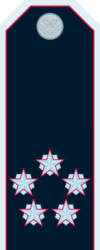
|

|
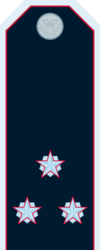
|
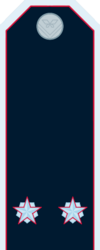
|

|

|

|

|
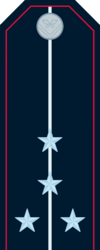
|
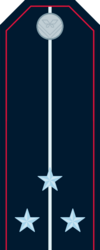
|

|
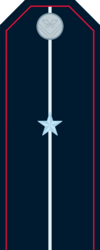
|
| Rank | Fleet Admiral | Admiral | Vice Admiral | Rear Admiral | Flag Captain | Captain 1st Rank | Captain 2nd Rank | Captain 3rd Rank | Senior Lieutenant | Lieutenant | Junior Lieutenant | Ensign |
| Abbreviation | FADM | ADM | VADM | RADM | FCPT | CPT1 | CPT2 | CPT3 | SLTN | LTN | JLTN | ENS |
Warrant officers
Enlisted personnel
| Category | Chief petty officers | Petty officers | Seaman rates | ||||||||||
|---|---|---|---|---|---|---|---|---|---|---|---|---|---|
| Int. rank code | OR-9 | OR-8 | OR-7 | OR-6 | OR-5 | OR-4 | OR-3 | OR-2 | OR-1 | ||||
Right shoulder insignia |
File:RPN mcn.png | 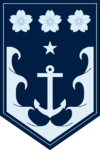
|
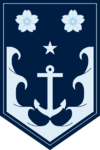
|
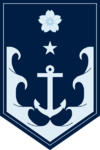
|
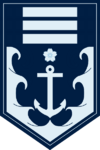
|
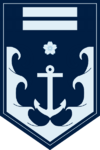
|
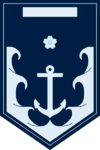
|
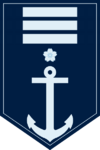
|
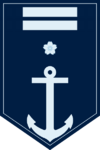
|

|

|
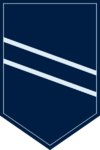
|

|
| Rank | Master Chief Petty Officer of the Navy | Force Master Chief Petty Officer | Command Master Chief Petty Officer | Master Chief Petty Officer | Command Senior Chief Petty Officer | Senior Chief Petty Officer | Chief Petty Officer | Petty Officer 1st Class | Petty Officer 2nd Class | Petty Officer 3rd Class | Seaman | Seaman Apprentice | Seaman Recruit |
| Abbreviation | MCN | MCF | MCC | MC | SCC | SC | CPO | PO1 | PO2 | PO3 | SN | SA | SR |
Approximately 80% of the Royal Pelinese Navy’s personnel are enlisted; subcategories in the RPN rank system include, in order of increasing responsibility, seaman rates, petty officers, and chief petty officers.
The working uniform worn by enlisted sailors on Pelinese warships consists of a Type 017 fire-retardant battle dress uniform patterned in red UFA camouflage, Type 004B tanker boots, and an optional red baseball cap with the ship’s badge. The office uniform consists of a dark blue office shirt and pants, as well as black dress shoes.
Rank insignia for enlisted personnel are worn on the upper right sleeve, while a Royal Pelinese Navy service insignia is worn on the upper left sleeve. Technical specializations are indicated by a badge worn over the uniform’s nameplate.
Contemporary topics
Strategic doctrine and priorities
The Royal Pelinese Navy has historically concentrated the vast majority of its strategic planning on the theaters of the Mediterranean Sea and the Eastern Ocean, which constitute the maritime regions immediately bordering Pelinai; continuing Livanan claims on the Marahu Delta and Zholtiya regions, as well as a lack of acute naval threats from elsewhere, led most contemporary naval officers to prioritize the areas of coastal defense and other defensive operations until the early 2000s. The withdrawal of these claims, along with other factors such as the continued presence of Emeraldian warships in the Mediterranean, the recent formation of the Concordia Entente, and the increasing industrial and technological capacity of the Pelinese state, have since resulted in a long-term doctrinal shift in the navy; an expanded level of responsibility in furthering Pelinese security and interests against newer, more varied threats has resulted in a wide-reaching series of naval rearmament and reorganization initiatives. These campaigns have made substantial progress in developing the modern Royal Pelinese Navy into a powerful naval warfare force capable of successfully waging all levels of military conflict against sophisticated, highly advanced adversaries.
Published statements and directives by high-ranking Pelinese naval officers, such as Fleet Admiral Georgiy Kaigin and Admiral Haru Koraba, have repeatedly emphasized the necessity of a powerful navy to maintaining Pelinai’s security in the modern era. Admiral Koraba stated in April 2022 during an interview with the Pelograd Apostle that the RPN continued to maintain plans for further improvement of its capabilities, continuing that the Navy was a necessary counterbalance against the other major naval powers in the Mediterranean.
Force restructuring efforts of the RPN have focused on the sectors of expanded ship capability and range, expansion of ship type variety, addition of new aerial systems, and increases to both the size and quantity of operational task forces. Newer surface combatant designs such as the Umihana destroyers have prioritized increased operational range and endurance, and have implemented great improvements in the performance and reliability of Pelinese naval powerplants, ship electronics and sensors, weaponry, and other systems. The addition of aircraft carriers to the Pelinese combined fleet introduces critical capabilities in overseas power projection and fleet defense, and carriers have become the new central ship of the RPN’s reorganized surface task forces. Nuclear attack and guided missile submarines have massively increased the reach and flexibility of Pelinese operational groups, and nuclear ballistic missile submarines now underpin the second-strike credibility of Pelinai’s nuclear forces. Maritime surveillance drones and loitering munitions, of both land-based and ship-based varieties as well as fixed and rotary-wing models, add powerful and flexible reconnaissance and strike assets to the Pelinese inventory. Both the Mediterranean and Eastern Fleets have added substantial tonnage of ships in recent decades, with the current number of notional carrier battlegroups standing at 12 and the number of notional amphibious strike groups standing at 5. Expanded flotillas of missile cutters, corvettes, and diesel-electric submarines provide the RPN with a credible littoral combat element that complements its larger blue-water naval assets. Improved tactical-operational communications systems and procedures have extended the ability of RPN ships to effectively operate in tandem with shore-based patrol and strike aircraft such as the KaR-15 Umidori and the To-13 Botan.
The primary theater of military operations that the RPN is concerned with remains the Mediterranean Sea, to which the accompanying Mediterranean Fleet is assigned. Substantial combat and infrastructure elements introduced throughout the 2000-2015 period, including surface warships, conventional and nuclear submarines, maritime patrol and surveillance aircraft, and shore-based sensors have all added critical offensive and defensive naval capabilities to Pelinese forces in this region; the Mediterranean Fleet now possesses the full range of modern naval-based power projection elements, and benefits from extensive strike and C4ISTAR support by land-based aircraft of both the Navy and the Royal Pelinese Air Force.
The increasing ability of RPN forces to operate in force at long distances from domestic coasts has the potential to functionally extend Pelinese strategic depth up to a thousand kilometers offshore in the event of a conflict. Such an extension would greatly increase the reach of the Pelinese integrated air and missile defense system, severely complicating the direction of over-water air or missile attacks against targets in mainland Pelinai.
Bases
Mediterranean Sea
Eastern Ocean
Amaboshi
The largest military harbor in Pelinai is the port of Amaboshi on the eastern Stelossian coast, which acts as the designated headquarters of the Mediterranean Fleet and docks the majority of large surface combatant forces assigned to it. Two squadrons of MPA aircraft and a squadron of maritime surveillance drones are additionally stationed at the adjoining Yukihana Naval Air Station, which perform coastal patrol duties.
Equipment
As of the end of 2025, the Royal Pelinese Navy operates 842 commissioned warships and auxiliary vessels, approximately 900 aircraft including navalized multirole and strike fighters, AEW&C aircraft, transport aircraft, and naval utility helicopters, as well as land-based aircraft such as maritime patrol aircraft, aerial refueling tankers, HALE maritime surveillance drones. Pelinese military vessels operate modern radars and fire control systems, missile systems, and other equipment.
Ships and submarines
The Royal Pelinese Navy operates approximately 351 combat warships, including 12 aircraft carriers and 113 submarines. Vessels of the RPN are overwhelmingly designed and constructed within Pelinai using domestically sourced components, although some interest has been expressed in purchasing coastal patrol craft from Weisserstein.
Pelinai has operated the full range of naval warships since 2009, including aircraft carriers, amphibious warfare ships, conventional and nuclear-propelled attack submarines, nuclear-propelled guided and ballistic missile submarines, and underway replenishment craft, as well as surface combatants ranging from missile cutter to cruiser size.
Aircraft
Approximately 900 aircraft of various types are operated under the Royal Pelinese Navy, including piloted fixed-wing and rotary-wing aircraft as well as various types of UAVs.
The Royal Pelinese Navy Air Service operates a wide range of naval aviation assets, including ASW and utility helicopters, shore-based maritime patrol aircraft and surveillance drones, and weapons targeting drones; carrier air wings further possess navalized fixed-wing aircraft such as multirole fighters, AEW&C aircraft, and transport aircraft. All aircraft currently in RPNAS service are produced domestically in Pelinai, and most airframe models were also designed there as well.
Pelinese ship-mounted weaponry includes a variety of surface-to-air, ship-to-ship, land-attack cruise, and point defense missiles, as well as autocannons, Close-In Weapon Systems, naval cannons, and torpedoes. RPN missiles are normally installed inside VLS blocks, but some larger, long-range cruise missiles use prominent deck launchers instead.
The Royal Pelinese Navy possesses one of the largest single-nation inventories of naval mines in the world, and is capable of deploying them from ships, submarines, and aircraft. Deployed mines may be contact-based or influence mines.
Long-term military priorities of the Royal Pelinese Navy center around establishing naval supremacy in the Mediterranean Sea and expanding Pelinese sea-based power projection capabilities. Significant expansion, reformation, and modernization programs have been implemented and continue to be implemented in all branches of the RPN in the interest of attaining these objectives: Massive increases in the quantity and quality of all types of RPN combat assets, which are projected to be supported by a further several dozen vessels within the next decade. Improvements in branch interoperability with the RPAF now allow for more effective land-based strike support, and new surveillance assets such as the AURORA over-the-horizon radar array, EMDA and EMOSA hydrophone installations, and the Atēru satellite imaging surveillance network add substantial improvements to situational awareness in critical maritime theaters. Progress in the Pelinese space program is expected to bring additional space-based sensor and targeting support assets into operation.
The Royal Pelinese Navy is currently in the process of recapitalizing portions of its surface combatant and submarine forces, covering destroyers, corvettes, diesel-electric attack submarines, and mine warfare vessels. Ship runs completed in the late 1990s and early 2000s will reach the end of their 30-year design service lives throughout the next decade, necessitating new construction of replacement vessels; several frigates are also receiving extensive upgrades to their radar systems and other electronics.
The KPF Kihana is testing a ship-borne, directed energy-based CIWS assembly intended for usage against drones, missiles, and aircraft.
The Royal Pelinese Navy is currently in the process of adopting wide-bandgap semiconductor based naval radar systems, primarily using gallium nitride (GaN), in order to increase effective transmission power and concomitant anti-stealth capabilities.
